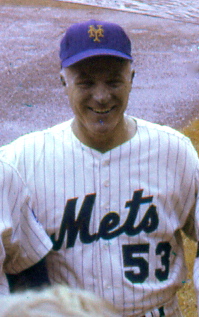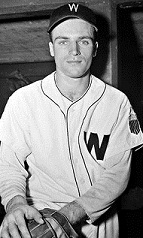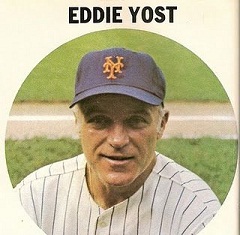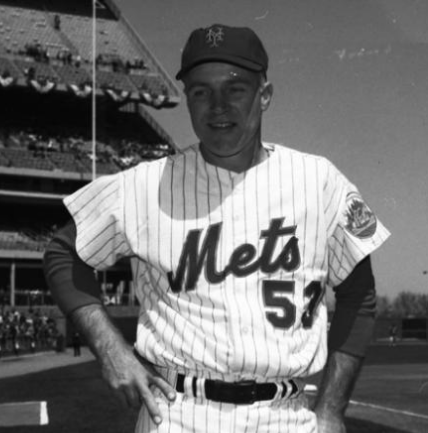 Eddie Yost, whose 8 years as a Mets coach is third longest in team history, passed away on Tuesday. He was 86.
Eddie Yost, whose 8 years as a Mets coach is third longest in team history, passed away on Tuesday. He was 86.
Born in Brooklyn on October 13, 1926, Edward Frederick Joseph Yost was signed as a 17 year old straight out of high school by Washington. After serving his country in World War II the following year, Yost returned stateside and was immediately put on the Senators roster. He never played in the minors.
He was nicknamed ‘The Walking Man’ for his uncanny propensity to draw walks. He was regarded to be the best lead-off hitter of his day as well as one of the best defensive third baseman in the league. Over the course of his 16 year career, Yost walked 1,614 times. Eight times he topped 100 walks in a season. At the time of his retirement, only Babe Ruth, Ted Williams and Mel Ott had drawn more bases on balls. His greatest total was 151 in 1956. That season his batting average was a meek .231, but he offset that was a .412 OBP.
His best offensive season was 1950 where he matched a .440 on-base percentage with a career high .295 batting average. “Because I could draw walks, pitchers treated me like I was a .400 hitter,” Eddie once commented. An opposing manager, in an effort to motivate his staff, began charging his pitchers $25 every time they walked Eddie. This practice was short lived when his staff complained of being in debt hundreds of dollars to the manager. Senators owner Clark Griffith stated, “I wouldn’t trade Yost for Mantle straight up.” Casey Stengel, who managed the Yankee dynasty throughout the 50’s, wanted desperately to add Yost to his roster. Baseball historian Phil Wood said, “He reached the point where the umps said if Eddie didn’t swing at the pitch, they wouldn’t call it a strike.”
it a strike.”
In addition to reaching base via the walk, Yost also set the major league record of the most HR’s to lead-off a game with 28, a record that stood until Bobby Bonds in the 1970’s.
In addition to living up to his nickname of The Walking Man, Eddie also led AL third basemen in put-outs 8 times, double plays 7 times, assists 3 times and fielding percentage twice.
From August 30, 1949 to May 11, 1955. Eddie played in 829 consecutive games, 8th longest streak in history.
In December 1958, Washington decided to part ways with their Yost after 14 seasons. They needed to make room for a young rookie named Harmon Killebrew and Eddie was traded to the Tigers. That following season, his first year with Detroit, Yost hit a career high 21 HR’s and led the AL in Runs, OBP and walks.
After 2 seasons with Detroit, Yost was picked up in the expansion draft by the Los Angeles Angels. He became the first batter in Angels history.
He retired in 1962 with a mediocre .254 career batting average, 683 RBI’s but an impressive .394 OBP. He returned back east where he became a third base coach for Washington and their manager Mickey Vernon. When Vernon was replaced, the Senators’ new manager requested Yost to stay on board. That new manager was named Gil Hodges.
When Hodges accepted a managerial job in New York, he brought Eddie with him. Yost served as Mets 3b coach from 1968-1975.
Eddie believed in small ball before small ball was cool. He realized the importance of reaching base and playing solid defense. This mantra fit in well with the Mets of that time who were heavy on pitching but light on offense. Yost was influential in the defensive development of Mets infielders, especially Wayne Garrett and Buddy Harrelson, the latter who tried to emulate Yost. Eddie realized the Mets hitting was anemic and he’d frequently wave runners around 3rd, trying to scratch out every run possible.
Eddie played in the majors 16 years, mostly with the hapless Senators, and never even came close to a post-season. It was during his time as Mets coach when, in 1969, he received what every player dreams of: A World Series ring.
During his playing days, Eddie enjoyed repairing antique clocks. In the 1950’s, he became the player rep for the AL and spoke before Congress on Baseball’s anti-trust. He also fought hard to increase the minimum salary and player pensions. During the off-season he attended NYU where he earned a Masters Degree in Physical Education.
His final at-bat came July 28th, 1962 when he was used as a pinch hitter. As one would expect, Eddie drew a walk.















